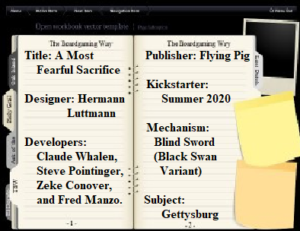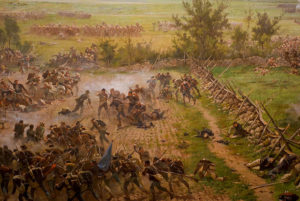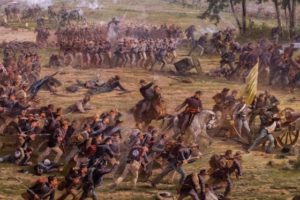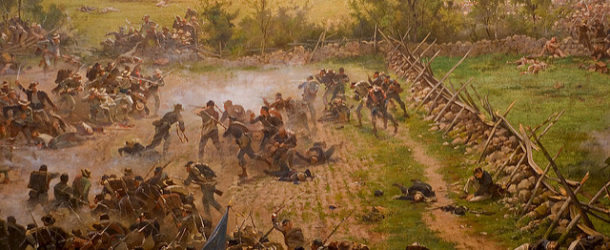“Making Sausage: All this Is My Fault – Pickett’s Charge”
By Claude Whalen:
 You would think that making a Pickett’s Charge scenario would be simple; march across open ground, get blasted along the way, and then crash into the Union line. A simple three-hour scenario, simple to make, right? Well, no; in my first three tests, the Rebels had dominant wins, 13-9, 13-9, 16-6! Something was clearly wrong when the Rebels kept dominating the Union. In order to adjust the game, the Lee card was removed so Longstreet ran the show alone. Getting any sort of historical result from “Pete” was impossible (one or two brigades made it to the Union line) thus the Union won 19-3 and 22-0. It was time for another tweak.
You would think that making a Pickett’s Charge scenario would be simple; march across open ground, get blasted along the way, and then crash into the Union line. A simple three-hour scenario, simple to make, right? Well, no; in my first three tests, the Rebels had dominant wins, 13-9, 13-9, 16-6! Something was clearly wrong when the Rebels kept dominating the Union. In order to adjust the game, the Lee card was removed so Longstreet ran the show alone. Getting any sort of historical result from “Pete” was impossible (one or two brigades made it to the Union line) thus the Union won 19-3 and 22-0. It was time for another tweak.
Lee was now re-introduced into the game for turn #1 and then removed for the rest of the scenario. His initial presence gave the Rebels that extra boost to get to Cemetery Ridge in the first hour. There was another problem though, as in all other scenarios with a CIC card, it can be held for later use. After a number of plays (one of which was a 12-0 Union win), there was a clear gamey strategy that needed to be fixed.
 If I got the Lee card before Longstreet came out of the deck, I would hold it, keep Pickett safely on Seminary Ridge and wait for the Longstreet card. Once I had both cards, I would play both cards back to back and march most, if not all, of Pickett’s Division across the valley and attack the Union line. Note that the Union artillery couldn’t fire as Pickett made his double move sprint towards their line. Three plays (12-10 USA) and (15-7 USA) were basic lessons in not charging strong gun positions frontally. Canister defensive fire can crush an attack quickly. The third try was a Rebel victory in the making until Pickett got hit, which made for a deceptive Union win. Still, Pickett should not be able to cross the valley without getting shot at by the Union artillery.
If I got the Lee card before Longstreet came out of the deck, I would hold it, keep Pickett safely on Seminary Ridge and wait for the Longstreet card. Once I had both cards, I would play both cards back to back and march most, if not all, of Pickett’s Division across the valley and attack the Union line. Note that the Union artillery couldn’t fire as Pickett made his double move sprint towards their line. Three plays (12-10 USA) and (15-7 USA) were basic lessons in not charging strong gun positions frontally. Canister defensive fire can crush an attack quickly. The third try was a Rebel victory in the making until Pickett got hit, which made for a deceptive Union win. Still, Pickett should not be able to cross the valley without getting shot at by the Union artillery.
So the solution became that the Rebels end their barrage, any one Rebel Division (if it isn’t Pickett, you lose) gets an automatic move (the auto move replaced the Lee card) and then BOTH sides can fire artillery before the first card is drawn. Even if the first card drawn is Longstreet, the Rebels still stopped mid-field and took Union artillery fire. Nevertheless, the Rebels are now able to cross the valley in one hour and the Union can fire at them along the way.
Still more testing revealed another issue with the scenario border. Initially, the Rebels could turn the Union left in this scenario, and in one game, the Rebels actually got BEHIND Cemetery Ridge, took the Union from the rear, and won the game 14-6. Again, it was something that should not be “doable”. The solution was to expand the southern border of the scenario, which added two strong Union batteries and made it much harder for the Rebels to breakthrough.
 After additional testing, the game seemed to be very realistic. Classical frontal charges will get you results like 16-6 and 15-7 Union victories. Yet there is a chance for the Rebels; not because the scenario has a flaw, there just was a better way for the Rebels to attack. In my final test, it was a 12-10 Rebel lead until the final Union card. A crushing counter-attack on the disorganized Rebels flipped the final score to 16-6. That type of result makes for an entertaining scenario!
After additional testing, the game seemed to be very realistic. Classical frontal charges will get you results like 16-6 and 15-7 Union victories. Yet there is a chance for the Rebels; not because the scenario has a flaw, there just was a better way for the Rebels to attack. In my final test, it was a 12-10 Rebel lead until the final Union card. A crushing counter-attack on the disorganized Rebels flipped the final score to 16-6. That type of result makes for an entertaining scenario!
With that result, the scenario is ready for you to play. If you only play it once, it probably will be a decisive Union victory and you will miss the strategy that gave Lee that glimmer of hope that the charge could work. I’m not going to give you any clues but the Rebels best chance is in there. In real life, Lee had only one try and we all know how that worked out. For us, we try, fail, set up our cardboard armies again, and try something different. Good luck, gentlemen!
[Note: “A Most Fearful Sacrifice” will be published sometime later this year by “Flying Pig Games.” it was designed by Hermann Luttmann and developed by Claude Whalen, Steve Pointinger, Zeke Conover, and Fred Manzo – that’s me! – Fred]








